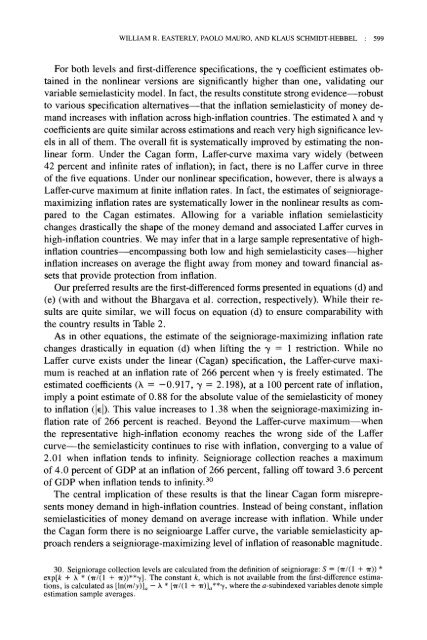Money Demand and Seigniorage-Maximizing ... - William Easterly
Money Demand and Seigniorage-Maximizing ... - William Easterly
Money Demand and Seigniorage-Maximizing ... - William Easterly
You also want an ePaper? Increase the reach of your titles
YUMPU automatically turns print PDFs into web optimized ePapers that Google loves.
WILLIAM R. EASTERLY, PAOLO MAURO, AND KLAUS SCHMIDT-HEBBEL : 599<br />
For both levels <strong>and</strong> first-difference specifications, the y coefficient estimates obtained<br />
in the nonlinear versions are significantly higher than one, validating our<br />
variable semielasticity model. In fact, the results constitute strong evidence-robust<br />
to various specification alternatives-that the inflation semielasticity of money dem<strong>and</strong><br />
increases with inflation across high-inflation countries. The estimated A <strong>and</strong> y<br />
coefficients are quite similar across estimations <strong>and</strong> reach very high significance levels<br />
in all of them. The overall fit is systematically improved by estimating the nonlinear<br />
form. Under the Cagan form, Laffer-curve maxima vary widely (between<br />
42 percent <strong>and</strong> infinite rates of inflation); in fact, there is no Laffer curve in three<br />
of the five equations. Under our nonlinear specification, however, there is always a<br />
Laffer-curve maximum at finite inflation rates. In fact, the estimates of seignioragemaximizing<br />
inflation rates are systematically lower in the nonlinear results as compared<br />
to the Cagan estimates. Allowing for a variable inflation semielasticity<br />
changes drastically the shape of the money dem<strong>and</strong> <strong>and</strong> associated Laffer curves in<br />
high-inflation countries. We may infer that in a large sample representative of highinflation<br />
countries encompassing both low <strong>and</strong> high semielasticity cases-higher<br />
inflation increases on average the flight away from money <strong>and</strong> toward financial assets<br />
that provide protection from inflation.<br />
Our preferred results are the first-differenced forms presented in equations (d) <strong>and</strong><br />
(e) (with <strong>and</strong> without the Bhargava et al. correction, respectively). While their results<br />
are quite similar, we will focus on equation (d) to ensure comparability with<br />
the country results in Table 2.<br />
As in other equations, the estimate of the seigniorage-maximizing inflation rate<br />
changes drastically in equation (d) when lifting the y = 1 restriction. While no<br />
Laffer curve exists under the linear (Cagan) specification, the Laffer-curve maximum<br />
is reached at an inflation rate of 266 percent when y is freely estimated. The<br />
estimated coefficients (A =-0.917, y = 2.198), at a 100 percent rate of inflation,<br />
imply a point estimate of 0.88 for the absolute value of the semielasticity of money<br />
to inflation (|e|). This value increases to 1.38 when the seigniorage-maximizing inflation<br />
rate of 266 percent is reached. Beyond the Laffer-curve maximum-when<br />
the representative high-inflation economy reaches the wrong side of the Laffer<br />
curve the semielasticity continues to rise with inflation, converging to a value of<br />
2.01 when inflation tends to infinity. <strong>Seigniorage</strong> collection reaches a maximum<br />
of 4.0 percent of GDP at an inflation of 266 percent, falling off toward 3.6 percent<br />
of GDP when inflation tends to infinity.30<br />
The central implication of these results is that the linear Cagan form misrepresents<br />
money dem<strong>and</strong> in high-inflation countries. Instead of being constant, inflation<br />
semielasticities of money dem<strong>and</strong> on average increase with inflation. While under<br />
the Cagan form there is no seignioarge Laffer curve, the variable semielasticity approach<br />
renders a seigniorage-maximizing level of inflation of reasonable magnitude.<br />
30. <strong>Seigniorage</strong> collection levels are calculated from the definition of seigniorage: S = (s/(1 + s)) *<br />
exp[k + A * (w/(1 + s))**^y]. The constant k, which is not available from the first-difference estimations,<br />
is calculated as [ln(m/y)]a-A * [s/(1 + s)]a**#Y where the a-subindexed variables denote simple<br />
estimation sample averages.


